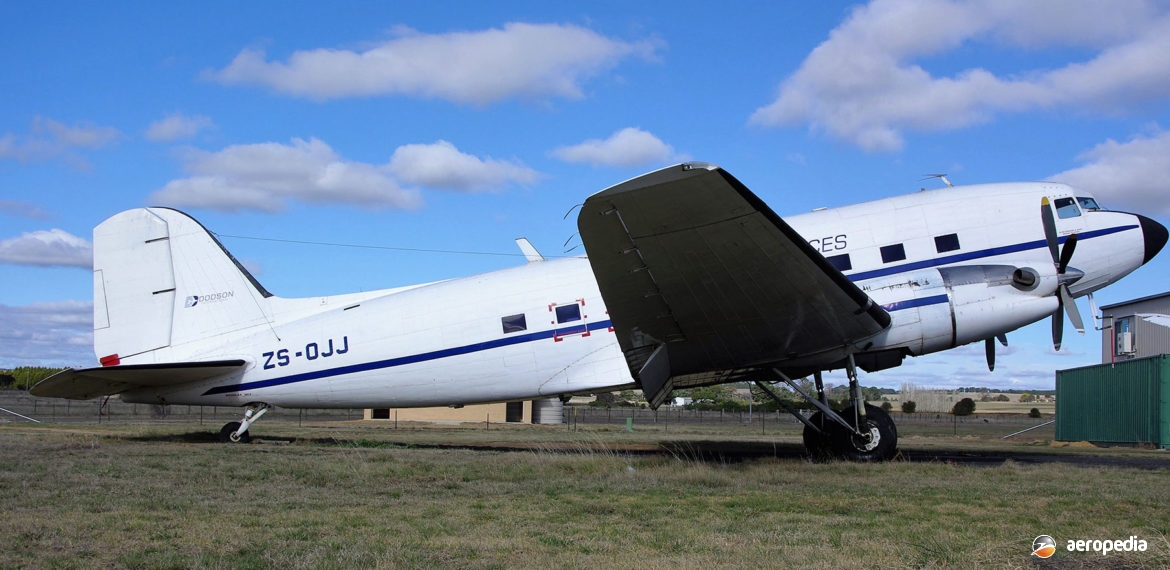Photograph:
Douglas DC-3C-TP ZS-OJJ (c/n 16213) whilst operating on skydiving from Goulburn, NSW (David C Eyre)
Country of origin:
United States of America
Description:
Commercial transport
Power Plant:
Two 918 kw (1,230 shp) Pratt & Whitney PT6A-65AR turboprops
Specifications:
- Wingspan: 28.96 m (95 ft)
- Length: 19.66 m (64 ft 6 in)
- Height: 5.16 m (16 ft 11½ in)
- Wing area: 91.7 m² (980.7 sq ft)
- Cruising speed at 3,658 m (12,000 ft): 362 km/h (225 mph)
- Max rate of climb: 475 m/min (1,560 ft/min)
- Certified ceiling: 7,315 m (24,000 ft)
- Max range: 2,484 km (1,543 miles)
- Fuel capacity: 3,899 litres (858 Imp gals)
- Max payload weight: 6,000 kg (13,225 lb)
- Loaded weight: 12,202 kg (26,900 lb)
History:
Over the years a number of conversions have been made to the Douglas DC-3 / C-47 series to increase performance. This has usually involved the installation of turboprop power plants. One of the largest companies carrying out these conversions was Basler Turbo Conversions of Oshkosh, Wisconsin in the United States. These conversions, known as the Basler Turbo 67, involved the installation of two Pratt & Whitney PT6A-67R turboprop engines. The converted aircraft met Stage III Noise Certification requirements and had new fuel, hydraulic, electrical and avionics systems installed.
Examples were sold to the air forces of El Salvador, Guatemala, Mali, Mauritania, Thailand, Bolivia and Colombia. Examples were also used on Geophysical Survey work in South Africa and others on adventure tour work in the Antarctic.
A number of other DC-3s were also converted to turbine power in South Africa in the late 1980s, the turboprop conversion increasing the time between overhauls of the engines from 1,800 flight hours to 6,000 flight hours, increasing load capacity by 27 per cent, increasing cruising speed by 74 km/h (46 mph) but using 30 per cent more fuel. One of these in 2003 was sold in the United States (N200MF) where it took up duties with Missionary Flights International at Fort Pierce, Florida, for missionary work in the West Indies.
The first example of the turbine powered DC-3 to operate in this region was ZS-OJJ. This aircraft was built for the USAAF as a C-47B-30-DK Skytrain and operated in World War II as 44-76629 before being transferred to the RAF as a Dakota IV (KN483) on 3 April 1945. It saw service in the Middle East before being transferred to the South African Air Force as serial 6855. After conversion to turbine configuration it was operated by Dodson International Charter and conducted relief flights in Africa until 2006 when it was offered for sale. Sold to an Australian entity, it was flown to Australia, arriving at Camden, NSW on 4 November 2006 from where it commenced charter and freight work. For a period it was based at Goulburn, NSW and used for parachuting but in April 2009 it was exported to the United States.
A Basler BT-67 conversion of the DC-3 ZS-ASN (c/n 16833/33581 – ex A2-ADL, ZS-ASN, PR-MGF, PT-WXE, ZS-ASN, PR-MSY) of Spectrem Air, South Africa, a division of the Anglo American Corporation, arrived in Australia on 17 August 2009 from Canada and was used for survey work, eventually departing for Denpasar on 4 April 2010. It returned again in 2011 for a further survey contract, remaining in central Australia until 12 September 2012 when it left from Broome, WA travelling to Denpasar, Indonesia for further contract work. It again arrived in Perth, WA in November 2017 after a trip taking eight days, commencing work from Nova Airstrip east of Kalgoorlie,WA.
A further Basler BT-67 of Ken Borek Air Ltd C-GJKB (c/n 13383) was chartered by the Australian Antarctic Division for the 2012-2013 summer season for conveying passengers and freight between Antarctic stations.
On 24 February 2013 a further DC-3 / BT-67 arrived in Darwin, NT. This aircraft C-FTGX (c/n 14324) in the markings of Bell Geosearch Aviation was fitted with a MAD boom and thereafter commenced fulfilling a contract for a mining company.

